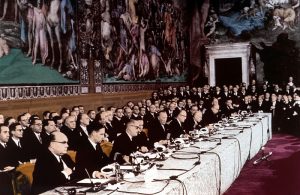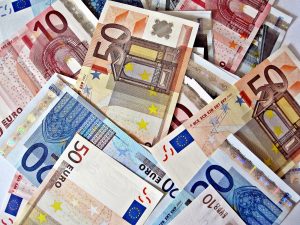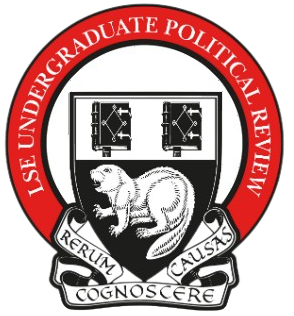Home to 27 member states, the European Union (EU) is a supranational economic and political organisation. To facilitate political peace and resolve the tensions arising from World War II, the EU was formed to deepen ties between European nations.
Since its formation, the EU has become the world’s largest economy and the top trading partner for 80 countries. Moreover, the EU also ranks first in both inbound and outbound international investments. The formation of the EU has created net benefits both politically and economically. To understand the EU’s global dominance, this article will provide an overview of its development and expansion.
The Beginning
In 1951, six European countries (Germany, France, Italy, the Netherlands, Belgium and Luxembourg) signed a treaty to create a common market for coal and steel. Coal and steel were placed under a common management system, creating the economic incentive to maintain unity. Not only were coal and steel considered core drivers of European economic growth, but the materials were also the “principal materials needed for the conduct of war”. Thus, the creation of the common market was contingent on this logic: that the economic integration of steel and coal production would reduce the likelihood of an outbreak of war. 
The signing ceremony of the Treaty of Rome on March 25, 1957. / Image: Poma (distributed via CC0 1.0 DEED)
The Treaty of Rome created the European Economic Community (EEC) in 1957. It established a common market for Germany, France, Italy, Luxembourg and the Netherlands, thereby building the foundation for further integration. The treaty designed a single economic area based on the four freedoms of movement: goods, people, services, and capital. Even today, the four freedoms are integral pillars of the European Union.
Aside from economic integration, the Treaty of Rome established common institutions to work towards a “common European goal”. Namely, the Treaty established the Council of the European Union, the European Commission, the Parliamentary Assembly of the Council of Europe, and the European Court of Justice. The Treaty of Rome created long-lasting institutions that are imperative to the operations of the EU. The collective institutions create an incentive to converge politically, rather than to divide.
EFTA: An Alternative to the EEC
During the same period, the European Free Trade Association (EFTA) was formed. Formed in 1960, the EFTA was envisioned as an alternative bloc to the EEC. The core founding members were Austria, Denmark, Norway, Portugal, Sweden, Switzerland and the United Kingdom (UK).
Initially, the EFTA emerged as a sceptical response to the economic integration proposed by the EEC members. It aimed to reap the benefits of trade liberalisation without pursuing deep political integration.
The crucial difference between the EEC and the EFTA was that the EFTA did not operate a common external customs barrier. The absence of a common trade policy gave member states sufficient political sovereignty to negotiate their individual customs duties against non-EFTA members.
In 1972, Denmark and the UK left the EFTA to join the EEC. It became increasingly clear that the EFTA’s economic performance was inferior to the EEC’s. The combined GDP of EFTA members only amounted to about 50% of the EEC’s GDP in 1960.
Deeper Political and Economic Integration
The beginnings of integration in financial and economic systems started with the European Monetary System (EMS). The multilateral agreement, established in 1979, promoted cooperation between the central banks of EEC members. Intending to promote monetary stability, the EMS enabled adjustable exchange rates. This laid the foundation for further financial integration, such as the introduction of the EU’s common currency, the Euro.
The internal common market was introduced in 1987 through the Single European Act. The legislation created European decision-making processes to further unify European member states. It improved democracy by increasing EU member states’ powers to debate laws and veto the admissions of new member states. The act marked a turning point in rapidly increasing European integration. Politically, this removed barriers and encouraged closer relationships between member states.
Euro notes / Image: Images Money (distributed via CC BY 2.0 DEED)
Furthermore, the Maastricht Treaty (1992), as acknowledged by the EU itself, had a “profound impact on European integration”. The treaty, generating transformations in the EEC’s organisational characteristics, converted the EEC into a union. Furthermore, the Treaty created the Euro and the concept of EU citizenship. By transforming the concept of European identity, the EU became a tangible and important organisation for EU citizens. This legislation also enhanced the political and economic structure of the Union, providing a long-term opportunity for closer integration.
In 2009, the Treaty of Lisbon came into effect. In an attempt to increase democratic transparency, this legislation increased citizens’ involvement in policy proposals and extended Parliament’s power across different policy areas. It is clear that increasing the voice of European citizens is a key concern of the European Union expansion project, and the EU has aided in expanding democratic participation.
Has EU Integration been Successful?
From 6 to 27 member states, the EU has experienced 7 enlargement cycles. Notably, the European Union experienced its greatest enlargement in 2004. 10 Central and Eastern European countries with a combined population of almost 75 million joined the EU. The enlargement has been interpreted as a positive attempt to increase peace and boost the national economies of the new member states. In particular, the export growth rates of the new member states were 1118.3%.
Aside from economic gains, the deeper integration of Europe was significant in healing the political divisions associated with the Cold War. Depicted as united, the EU increased the incentives to cooperate with fellow European member states. On a global stage, the creation of common institutions has bolstered the European voice, enabling the EU to become an influential political actor.
Emerging Dangers: Euroscepticism
 Pro-Brexit banners outside of the UK Parliament / Image: ChiralJon (distributed via CC BY 2.0 DEED)
Pro-Brexit banners outside of the UK Parliament / Image: ChiralJon (distributed via CC BY 2.0 DEED)
However, opinion polls suggest that Euroscepticism is on the rise. The European Center of Populism Studies broadly defines Euroscepticism as the “opposition to the process of European integration”.
This culminated in 2016 when, in the United Kingdom European Union membership referendum, the UK electorate voted to leave the EU. 51.9 percent of voters were in favour of withdrawing from the EU – the EU had become a point of contention within the domestic politics of member states.
This problem is not unique to the UK either. Since the 21st century, opinion polls from various member countries depict a general decline in favourable impressions of the EU. The downward trend suggests that deeper European integration has increased dissatisfaction within the European populace. With public distrust embedded in political attitudes, this calls into question the long-term viability of the EU as an institution. The success of Eurosceptic politicians such as Geert Wilders could mean an incoming serious resistance against deeper European integration.
Conclusion
Whilst the rise of Euroscepticism has halted the speed of European integration, there are no immediate signs of political withdrawal movements from the EU. Indeed, populist candidates such as Marine Le Pen have softened their stance on the European Union. Le Pen stated that she does “not want to leave the EU”, a clear divergence from the ‘Frexit’ narrative that she expressed during the 2017 French Presidential elections. Le Pen’s behaviour signals a broader move of Eurosceptic politicians away from drastic withdrawals from the EU. The EU will likely need significant reforms to maintain the harmony of the union; however, as of now, it is evident that it is an important organisation that protects the rights and interests of European citizens. Marking a departure from the series of worldwide conflicts in the early 20th century, the presence of the EU has maintained peace across a diverse Europe.
By Ying Zeng
Cover image source: European Union Flag by Håkan Dahlström via Wikimedia Commons






